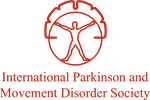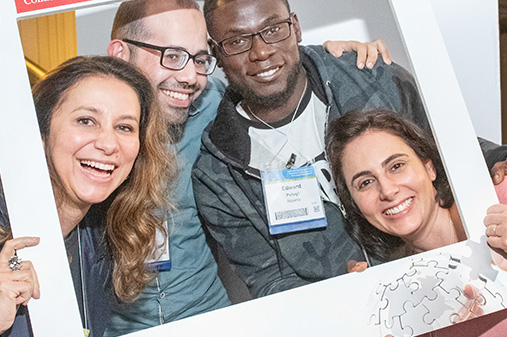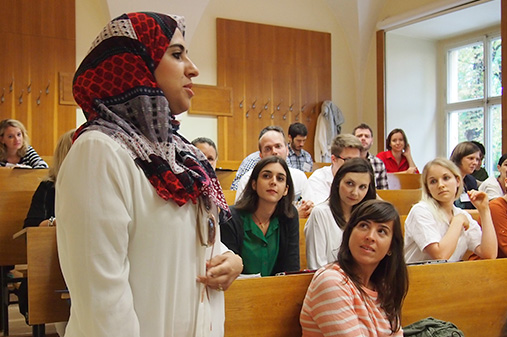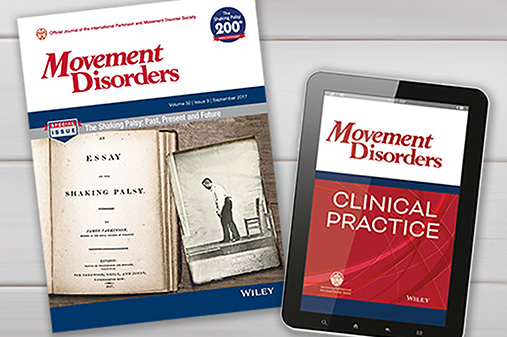Tremor Series: So common, so difficult: The phenomenology of tremor
[00:00:00] Dr. Alfonso Fasano: Hello and welcome to the MDS podcast, the official podcast of the International Parkinson and Movement Disorders Society.
I'm Alfonso Fasano, professor of neurology in Toronto, Canada. I'm also co chair of the study group on Tremor of our society. And I'm the guest editor for this new special series on Tremor. Today, I'm interviewing Petra Schwingenschuh who is a neurologist from Medical University of Katz in Austria, and she's here to discuss with us the phenomenology of tremor.
Viewc complete transcript
The title of this podcast is So common, so difficult: The phenomenology of tremor. Welcome, Petra. Thanks for joining us today.
[00:00:42] Dr. Petra Schwingenschuh: Thank you very much for the invitation.
[00:00:44] Dr. Alfonso Fasano: Now, our pleasure and obviously as we were chatting in the past you're known to the big public for your work on functional tremor and also lab based assessment, of tremor. But today we're going to dive into the clinical aspects of [00:01:00] tremor more in general. As the title says, this is a Common condition that we all deal with but it can be quite challenging to diagnose on clinical ground.
So let's start with a very simple, but a quite broad question to you, which is let's say someone with tremor shows up to your office, enters your office. So what's your first impression? How do you approach someone with tremor?
[00:01:21] Dr. Petra Schwingenschuh: Yeah the way I approach a new patient with tremor is starting asking some questions that I think are very important, which is the first one, when did the tremor start? Did it start suddenly? or did it arise slowly and then maybe progress over time? Which body part was affected first? Is it the same now or are now more body parts affected? When does the patient notice the tremor? Is it a tremor that occurs during rest or does it occur when he or she holds something or [00:02:00] is doing some activity like writing for example. And then I ask some other questions with regard to family history.
Is somebody else in the family who might have a tremor or another movement disorder? Does the tremor respond to alcohol? Does it get better with alcohol consumption? Is the patient already taking any medication for the tremor or any other medication, which might have another influence on the occurrence of tremor.
And then also during interviewing, I already observe the patient, and then when I start the clinical examination, I like to have a chair with an arm rest where the patient can put the arms on and the hands hanging freely so that the arms really are in a resting position.
If this is not available, I asked the patient to put the arms on his or her thighs. And [00:03:00] then I first have a look if there is a tremor at rest and which body parts are affected because this already helps me in my mind to get some differentials done at first. So is the head affected, the arms affected, the legs is it a asymmetric tremor, is just one body part involved, or is it something already addressed that involves for example, both limbs. And then I asked the patient to put the arms forward to have them outstretched at shoulder level at first and I look again is there a tremor at the posture? Postural tremor. Is it there already in this position? Then I ask, I look at another position. So I like to ask them to have the arms in a wing beating position and I have a look, okay, is it the tremor maybe increasing now in another position? And then I look at the tremor during action. So usually I do a finger nose testing.
I like to have them just in a sitting position because this is the usual way I'm [00:04:00] examining patients. I have them to have their arm, their legs outstretched and look if there is a postural tremor there. And then I ask them to hold a tone like, ah, to see if there is a voice tremor.
And then I think it's very important to have that they are doing some tasks. So at least I have each patient to draw a spiral and to write a sentence so that I can judge how is the tremor during these tasks. And then I always go with them to the sink and give them a glass of water and another glass and ask them to pour the water from one glass to the other and drink actually, so that I get an idea of how the tremor is during those daily activities.
[00:04:43] Dr. Alfonso Fasano: Very good. So this is very useful and obviously you start from the history taking and then you move on to the examination. In the examination, do you usually use a scale or how do you take note of the tremor? Do you use numbers? Do you refer to an existing assessment [00:05:00] tool?
[00:05:00] Dr. Petra Schwingenschuh: Yeah. So actually I like to have a scale so that I don't need to take more notes, more written notes. So I think it's easier actually to have a scale if it's a patient with a postural or a kinetic tremor. I like to use the TETRAS scale. And if it's a patient, where I'm suspecting PD. I like to have the UPDRS and to make some crosses because I think it's quicker actually for me than remembering everything. And sometimes if I'm in a rush I take notes and would write if it's a mild, moderate or severe tremor.
[00:05:38] Dr. Alfonso Fasano: Okay. Thank you. And so a few other things I would like to ask, because you mentioned lower limb, lower limb tremor. It's not as common as we used to think maybe, or for sure less common than arm tremor or upper limb tremor but when you assess the leg tremor, do you still keep the patient on a seated position or do you ever ask them to lie down?
How do you do that?[00:06:00]
[00:06:00] Dr. Petra Schwingenschuh: So if I'm in the possibility where I can have them lay down, I would lay them down and examine the postural tremor of the legs in a lying position. But I sometimes I think This is for all of us. It's not possible if you're in a rush or you don't have the possibility in the office.
So then I just get them in the sitting position to have their legs outstretched. And then, of course, I like to also examine the tremor again in an action position. So I have them stand up, look if the tremor is there or also if it's there during need heel shin test and during walking.
So that would be my approach to the legs.
[00:06:42] Dr. Alfonso Fasano: Okay, very good. Before we move to the legs, I think another reason to look into the lying position is to fully assess the rest tremor of the head, which is a type of tremor that is not really known to be public. So very few people actually ask the patient to lie down and see what happens to the head.
Because obviously when they're seated, [00:07:00] the head is keeping a posture. So does it happen that from time to time you ask them to lie down just to see what happens to the head tremor, particularly the rest part? Um,
[00:07:08] Dr. Petra Schwingenschuh: Yeah, So if I'm interested in the head I really like to lay them down because per definition, that's actually what we have to do to examine a tremor of the head. And then with regard to the head, it's also very important to see in which if they again, standing or sitting in which position I can see the heads or is it there in a neutral position or does it occur in a specific position like with a rotation or tilt of the head?
Does it get more in a certain position with regard to differential diagnosis because it would again, turn me towards a certain trauma syndrome.
[00:07:46] Dr. Alfonso Fasano: Particularly, I guess you're referring to dystonia, you're looking for a null point and see how the changes of the head position will affect the amplitude of the tremor. Moving forward to another important part of the examination that you mentioned is the [00:08:00] standing of the patient and the walking. And I think there is something more that can be said in that regard, especially with respect to orthostatic tremor.
What's your approach to orthostatic tremor?
[00:08:09] Dr. Petra Schwingenschuh: If I'm suspecting a tremor on standing or the history goes in this direction, actually, I first, of course, do a clinical examination, see if I can see with my eyes if there is tremor. and if there is actually nothing I can see, there is always in the literature that you get this helicopter sound in if you use a stethoscope, which actually, I think it's not always the case.
So this would be a patient if I'm suspecting an orthostatic trauma, it would be one of the patients where I would like to have neurophysiology.
[00:08:44] Dr. Alfonso Fasano: Absolutely. And that's actually something we can cover shortly. But before we get there, a few more points just your quick thoughts about it. So how important it is asymmetric to you, especially with respect to essential tremor, for example, something that we don't discuss [00:09:00] in depth enough, I think but is asymmetric tremor guiding you one way or another.
[00:09:05] Dr. Petra Schwingenschuh: I think it does in classical cases. Of course if I see a, asymmetric rest tremor. Of course, it's my first thought would be PD tremor. If it's a postural tremor and it's very symmetric and rhythmic my first thought would be essential tremor. But then if it gets more to an asymmetric tremor it might still be essential tremor but it might also be differential, I think becomes broader.
So a really striking asymmetry would more point towards other tremor syndromes, like maybe dystonic tremor or a cerebellar tremor. And of course if it's unilateral, the first thing we have to think about is a symptomatic tremor. So if it's really an abrupt onset of an unilateral tremor, it would be cause for us to ask for at least a CT scan of the brain.
[00:09:59] Dr. Alfonso Fasano: [00:10:00] Perfect. Thank you. And another quick practical point I would like to hear from you is the issue of which I struggle with sometimes of the transmission, the mechanical transmission of the tremor for one segment of the body to another, let's say someone with a very severe right hand tremor, and then you see some tremor on the right leg, and you don't know whether this is coming from the mechanical transmission from the upper limb, but really there is a tremor in the lower limb. Is there anything in particular you do to disentangle this type of situation?
[00:10:27] Dr. Petra Schwingenschuh: Um, Actually what I like to do is to get the patient in different positions to see if this helps with these questions. But I think in patients with a high tremor amplitude with severe tremors, this is always a very difficult question. So if it's really some intrinsic tremor of this extremity or if it's transmission.
[00:10:48] Dr. Alfonso Fasano: Very good. Okay. Thank you. And so moving on, there are important points that I would like to discuss with you from a clinical standpoint, if you can give us a few clues towards the very common situation [00:11:00] of a functional tremor. And lastly Approach tremor from using neurophysiology.
You mentioned using neurophysiology for orthostatic tremor, but we know obviously also from your work in neurophysiology can be used for functional tremor. So can you tell us a bit more about functional tremor on a clinical ground and then how neurophysiology can be used for functional and other tremors?
[00:11:20] Dr. Petra Schwingenschuh: Yeah. So I think the first thing is just to think about it, that it's an existing and common condition. And so with regard to clinical examination, the things that first come to my mind is to observe the patient, to see if there are some fluctuations in the body parts affected in the phenomenology of the tremor.
For example, if it's an upper limb tremor and we first see more pronation, supination tremor, and suddenly it changes to flexion extension. So this would something to point towards maybe functional origin. And then the main [00:12:00] thing really is distractibility. So if I observe that tremor stops, for example, during a conversation or while I'm doing for a task with the other hand, and the tremor stops this gives me a clue.
Or if the tremor stops during mental distraction. So these are like the general things. And then I'm, if I'm already suspecting a functional tremor, I'm also doing a tapping test to look for and train ability. I hold the patient's other limb. To see if there is, for example, a whack a mole sign and the tremor stops in this extremity but moves to another.
So then if I'm suspecting these things, really I look for distractibility and entrainment.
[00:12:45] Dr. Alfonso Fasano: Very good. And what about the use of technology or like an electro physiology more than technology? I should say.
[00:12:51] Dr. Petra Schwingenschuh: Yeah. So I think in functional tremor is sometimes, of course, it's clinically obvious you don't need any further tests, but if [00:13:00] you have any doubt, I think it's helpful to have a clinical neurophysiology first of all, to look for things that you're already looking for clinically, again, to look if there is distractibility, during for example, a tapping task, then to also note if the patient is performing the task correctly, because a wrong performance is another clue towards functional origin.
And then to see what happens to the other hand. So it's always important to record from both hands, to have one hand tapping and see is the tremor on the other hand, for example changing? And in addition to this, we look at co contraction because in functional tremor we typically have a co contraction and coherence between bilateral tremors.
Which is unusual for other forms of tremor. And this would be the main things I would look at, with regard to neurophysiology.
[00:13:58] Dr. Alfonso Fasano: Very good. Thank you. And of course, [00:14:00] this is a much bigger topic when you can use neurophysiology also to see the actual frequency of the tremor to see whether it's a tremor or myoclonus. But this becomes a bigger topic. And I'm sure you briefly mentioned another thing that I would like to remind our listeners that it is important to look at additional science. You indicated, for example, before that the presence of dystonia or the presence of cerebellar signs, and those are clues towards additional more in depth assessments of the tremor and to reach a final diagnosis. And in fact, in this podcast, we also looked into we'll discuss the issue of soft signs in essential tremor.
So more to come, but really want to thank you. Petra for your time and for really sharing with all of us your insights when it comes to the clinical and to some extent, electrophysiological assessment of tremor that, as we said, it's so common and so difficult. Thank you once again for accepting our invitation and for being part of this.
[00:14:54] Dr. Petra Schwingenschuh: Thank you.
[00:14:56] Dr. Alfonso Fasano: Our pleasure. And this was So common, so difficult: The [00:15:00] phenomenology of tremor with Dr. Petra Schwingenschuh from the University of Katz in Austria. And stay tuned for the other episodes of the podcast. Thank you all.

Petra Schwingenschuh, MD
Department of Neurology
Medical University of Graz
Graz, Austria









